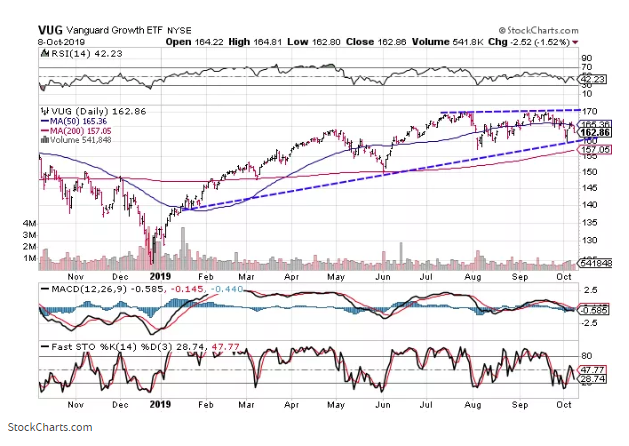There’s been a lot of talk lately in the capital markets that the growth factor is headed towards the exits like they’re favorite baseball team down 10-1 in the final inning. However, there can still be growth opportunities to be had in terms of looking at large cap growth.
A case-in-point example is in the chart of the Vanguard Growth Index Fund ETF Shares (NYSEArca: VUG).
“As you can see below, the price of the fund is trading within an ascending triangle pattern, which is often looked at as a consolidation pattern before making a sharp move higher,” wrote Casey Murphy in Investopedia. “The defined range creates clear levels for followers of technical analysis to place their buy and stop orders. In this case, active traders will most likely look to place buy-stop orders above $170 and protect against a sell-off by placing stop-losses below the ascending trendline or the 200-day moving average, depending on risk tolerance.”

“Factor investing is an important approach for investors to consider when seeking true levels of diversification while also being exposure to better-than-average returns,” wrote Murphy.
If investors do want to shy away from growth-oriented funds and just focus on value, they can opt for funds like the Deep Value ETF (NYSEArca: DVP). In times of heavy volatility, value funds can still be an option especially in the near-term horizon.
As such, there are incredible opportunities for investors to jump into equities while the default maneuver in today’s market landscape is heading into safe-haven assets like bonds or precious metals. Investors, however, could be missing out.
The shift to value in U.S. equities is readily apparent—per the U.S. News and World Report, “there has been at least a temporary shift in market leadership. After a decade of underperformance, value stocks outperformed the S&P in the first few weeks of September, while growth stocks lagged. While the debate rages on Wall Street as to whether this shift is temporary or an inflection point for value stocks, choosy investors can have the best of both worlds.”
DVP seeks to provide investment results that, before fees and expenses, correspond to the total return performance of the Deep Value Index. The Index is comprised of 20 undervalued dividend paying stocks within the S&P 500 Index with solid balance sheets, earnings and strong free cash flow. The companies within the Index are weighted based on a rules-based assessment of their valuations so that stocks that are most attractively valued receive a higher weight.
For more market trends, visit ETF Trends.

